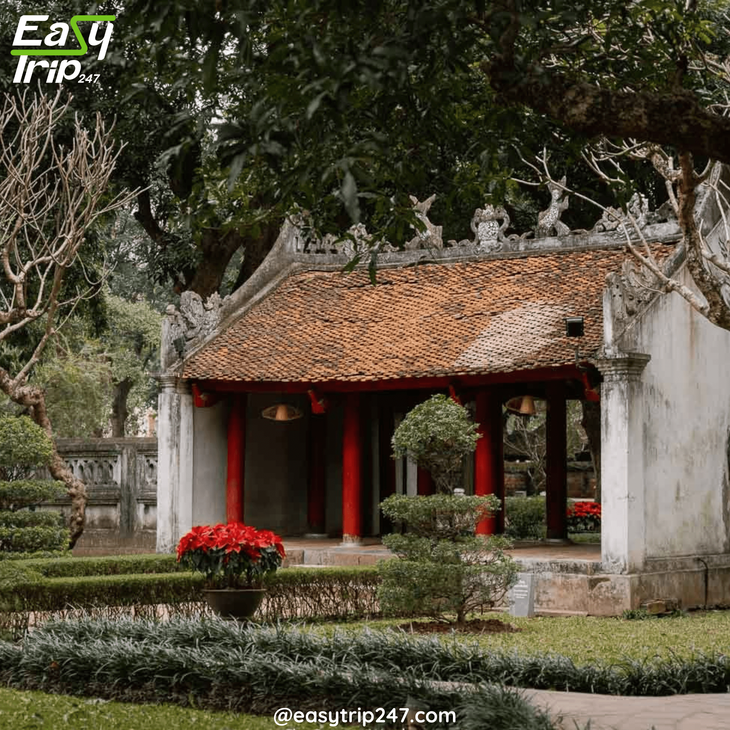A Walk Through the Serene Gardens of Hanoi’s Temple of Literature
On
23/06/2025Reading time:
1 min
Summary:
In a city where the buzz of scooters and the aroma of street food fill the air, it’s easy to forget that Hanoi also offers corners of complete serenity. Tucked away in the heart of the capital, the Temple of Literature Hanoi is a sanctuary of peace, tradition, and scholarly spirit.

From the moment you step through the majestic main gate, you’re embraced by the calming atmosphere of the Temple of Literature Hanoi. The transition from the chaotic rhythm of city life to the calm flow of the temple’s landscape is almost immediate. Here, the gentle rustle of leaves, the scent of jasmine, and the rhythmic sound of footsteps on ancient stone paths create an ambiance that inspires both reflection and admiration.
The layout of the Temple of Literature Hanoi is structured around five courtyards, each with distinct characteristics and landscaping, connected by a central walkway that leads you deeper into both nature and history. These gardens were not just designed for aesthetics—they were created with philosophical intention. Every tree, pond, and flower has its place in Confucian symbolism, representing harmony, balance, and the cyclical nature of life and learning.
The First Courtyard is a ceremonial entrance, flanked by tall trees that form a natural archway of shade and silence. Here, one feels the first whisper of nature’s presence in this sacred academic space. The trimmed lawns, well-kept hedges, and ancient trees—some said to be hundreds of years old—create a meditative landscape that encourages slow movement and thoughtful pauses.
As you move into the Second Courtyard, known as the Great Middle Gate, the serenity of the Temple of Literature Hanoi deepens. Stone pathways lined with bonsai trees guide your steps, each bonsai sculpted to embody patience and discipline—qualities revered in Confucian philosophy. It’s not uncommon to see students here, deep in study or quietly walking with purpose, perhaps hoping to absorb a touch of the temple’s timeless wisdom.
One of the most captivating garden features in the Temple of Literature Hanoi is the Well of Heavenly Clarity. This square-shaped pond lies at the heart of the temple and acts like a mirror to the sky. Lotus flowers bloom across its surface during summer months, adding a soft splash of pink and green to the otherwise solemn architecture. The reflection of the Pavilion of the Constellation of Literature in the water provides one of the most iconic views in all of Hanoi. The pond symbolizes clarity of mind—something every scholar needed before taking Vietnam’s historic imperial examinations.
The Third Courtyard leads visitors directly to this famous pavilion, an exquisite wooden structure perched on stone stilts. Surrounding the pavilion is a carefully manicured garden that radiates both elegance and discipline. This is where many travelers pause, take photographs, or simply sit in silence under the shade of trees. The way the natural elements frame the structure emphasizes the temple’s design philosophy—nature and knowledge, forever intertwined.
Perhaps the most poignant section of the Temple of Literature Hanoi is the Fourth Courtyard, which houses the altars of Confucius and his four most distinguished disciples. While the architectural beauty is profound, the adjacent garden areas offer a tranquil space for contemplation. With fragrant blossoms, neatly trimmed lawns, and trees that whisper with the wind, this courtyard exudes sacred calm. It’s here that many visitors choose to reflect, not just on the temple’s cultural legacy, but also on their own journeys and aspirations.
Wandering into the Fifth Courtyard, visitors arrive at the former site of the Imperial Academy—the very heart of Vietnam’s early education system. Today, reconstructed halls stand alongside beautiful garden areas where medicinal plants, traditional herbs, and symbolic flora grow. These gardens at the Temple of Literature Hanoi not only represent knowledge but also healing and growth. They’re reminders that education, like nature, requires nurturing and time to flourish.
What makes a walk through these gardens even more enchanting is the variety of plants and trees, many of which have been carefully chosen for their symbolic value. The banyan tree, often associated with spiritual significance in Vietnamese culture, provides generous shade and a place to rest. The frangipani, known for its delicate scent, is a symbol of loyalty and love. Each element has meaning, echoing the values taught at the academy centuries ago.
One of the joys of visiting the Temple of Literature Hanoi is observing how the gardens shift with the seasons. In spring, cherry blossoms and other floral trees burst into color, creating a dreamlike canopy over the temple grounds. Summer brings lush green vitality, while autumn covers the stone pathways in golden leaves. Winter, though quieter, offers a misty, ethereal quality that adds to the spiritual feeling of the site. Regardless of the time of year, the gardens remain a vital part of what makes the temple so memorable.
Photography lovers will find endless inspiration here. From the play of sunlight through the trees to the aged stone walls draped in creeping vines, every angle offers a chance to capture the quiet elegance of the Temple of Literature Hanoi. Early mornings are particularly magical, as the first rays of sunlight filter through the foliage, illuminating the dewdrops that rest gently on petals and leaves.
For those interested in cultural events, the Temple of Literature Hanoi occasionally hosts traditional music performances, calligraphy workshops, and student celebrations. During these moments, the gardens become animated with color and activity, yet they never lose their tranquility. In fact, the presence of such events reminds us that this is not just a monument of the past—it is a living, breathing symbol of Vietnam’s cultural continuity.
Even as the Temple of Literature Hanoi attracts thousands of visitors each month, its gardens manage to preserve a rare intimacy. They are places where individuals can connect with the past, find inspiration in the present, and feel the rhythm of nature around them. Whether you're a history enthusiast, a poet, a traveler, or someone simply seeking a quiet place to reflect, the gardens of this temple will not disappoint.
In conclusion, taking a walk through the serene gardens of the Temple of Literature Hanoi is more than a leisurely stroll—it's a cultural immersion, a spiritual refreshment, and a step into Vietnam’s poetic soul. The harmony between architecture, nature, and intellect creates an atmosphere unlike any other in the capital. With every step, you’ll feel more connected to the legacy of learning and more in tune with the natural beauty that has cradled it for nearly a thousand years.
So, the next time you find yourself in Hanoi, allow yourself to slow down, breathe in the fresh air scented with frangipani, and follow the stone paths beneath the leafy canopy. Let the gardens of the Temple of Literature Hanoi tell you their story—one of wisdom, peace, and enduring grace.
Design Your Tour Today And Get A Quote. Contact Us Here: +84.975.504.825
Source: Easytrip247 Team compiled.
